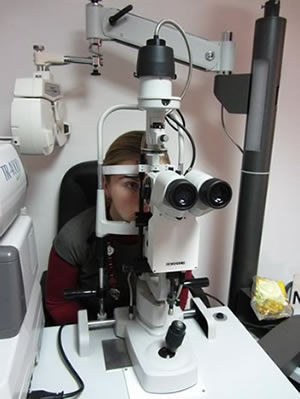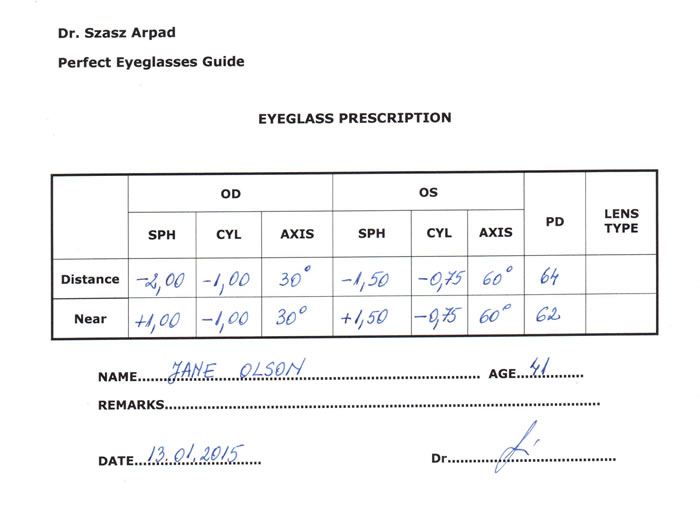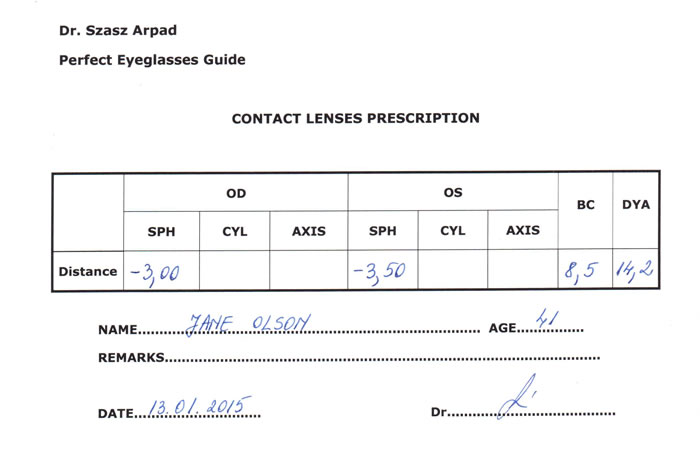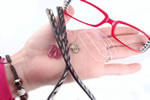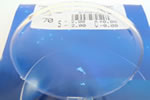Eyeglass Prescription Explained
You need an eyeglass prescription, if you want to make your first pair of glasses or you just change the old ones.
You already know that the first step is to visit an optometrist or the ophthalmologist.
The prescription is usually a piece of paper or plastic that contains your personal data needed to make a pair of eyeglasses.
But how many of you really know what is all that info written on the prescription? Or what is necessary to write there, so the optician can make a pair of efficient glasses using that data?
I will try to explain you what and why is written there.
Types of prescriptions
There are many types of prescriptions. I will show you an example to see how it should look for your information:
On the above prescription, you can see two types of data:
Mandatory data
Here we have: personal data, the diopters, interpupillary distance.
Personal data
This is your ID: name, age, gender everything that identifies you and is relevant for the optometrist.
The Diopter
This data is the most important part of the prescription. It represents your problem and its magnitude.
The diopter is a unit of measurement of the optical power of the eye, represented by numbers that shows the power of the lenses that compensate that problem.
Also regarding the diopter, on the prescription above we meet the following terms:
- OD and OS - These are Latin words. They tell you which eye the prescription is for."OD"(oculus dexter) is the right eye, "OS" (oculus sinister) is the left eye. Some prescriptions simply use RE (right eye) and LE(left eye)
- Distance - The diopters prescribed to help you see distant objects clearly
- Near - The diopters prescribed for a clear near vision
- Add - On some prescriptions, you will see the term "Add" instead of "Near". This number is used for bifocals and progressives, and it represents the added diopters to the distance prescription to get the near vision prescription.
- SPH - Indicates the value of lens power, prescribed to correct the "spherical error". A (+) means the prescription is farsighted, and a (-) means the prescription is nearsighted. The higher the number after (+) or (-), the stronger the prescription.
- CYL - indicates the severity of the astigmatism.
- AXIS - tells you which way the astigmatism is oriented.
- Prism - Sometimes you'll see this term on your prescriptions. It means the prism diopters needed to treat an eye disorder called phoria. Prism lenses have a thicker, and a thinner part called the base and the top.
You have here some examples for various eye diseases, of how it should look the diopter on the prescription:
Myopia:
|
SPH |
CYL |
AXIS | |
|
-2.50 |
-- |
-- |
Hypermetropia:
|
SPH |
CYL |
AXIS | |
|
+3.00 |
-- |
-- |
Astigmatism:
|
SPH |
CYL |
AXIS | |
|
-1.50 |
-1.00 |
150 |
On the above examples the numbers are just examples, but the signs of the numbers are how it should be in these different situations: (-) for myopia and (+) for hypermetropia.
Also, you can see that the cylinder and axis part is completed only in the case of astigmatism.
If you suffer from astigmatism, this is a more particular recipe because it has two diopters and an axis. It shows the magnitude of the vision problem and the correction possibilities.
You will see that this kind of prescription can be written in two ways, but the two means the same thing. It is important to know, because some optometrists like to write the prescription one way, others the other way and even they look different; they are the same.
There is a mathematical formula to calculate the diopters both ways. I will give you one example to see the difference, but you can ask your optometrist to write it down for you both ways:
- With (+) cylinder: -2.50 sph +3.00 cyl 5 axis
- With (-) cylinder: +0.50 sph -3.00 cyl 95 axis
These two ways are in fact the same thing. If you do have two prescriptions from two optometrists, you will think the diopters have changed, but, in fact is the same thing just written differently.
Interpupillary distance
This measurement decide the size of the frame. A small interpupillary distance asks for a smaller frame. It generally represents the distance between the two pupils, more exact the center of the pupils written in millimeters.
I say generally, because, in our shop, I use a different system which I think is more exact.
I measure the distance between the nose bridge and the center of the pupil separately for left and right eye.
I do this because if a patient has a problem with only one eye (strabismus) or a deviated nasal septum, the primary measurement is not exact. The same, I feel that is important to measure the distance separately when making progressive glasses because any small deviations will affect vision and adaptation.
Optional data
Usually, this represents your personal options for the eyeglasses and is not always written on the prescription as:
- The material of the lenses
- Coatings (hardening, anti-reflective)
- High index (for bigger diopters).
These options are not written only by the optometrist/ophthalmologist. They can be written by the optician also. This kind of data is usually used when you make your glasses in the same place you make the eye check, so they know your personal options.
The contact lenses prescription
A different kind of prescription is the one for contact lenses. Usually, it looks the same with a small difference. The mandatory part contains two more data types:
- BC - the curvature
- DIA - the diameter of the contact lenses.
If you have small diopters, like 1, 2 or 3, you should know that the lenses diopters are the same with the contact lens diopters. In the case of bigger diopters, there is a conversion table for matching the air lens with the contact lens diopters.
For example: if you have (-4.75 sph) on air lenses, you will have (-4.25 sph) on contact lenses.
This difference is because of the distance of the lens from the eyes and the material and characteristics of the contact lenses
Questions and answers about eyeglass prescription
Over time we have received many questions about the eyeglass prescriptions.
Here are a few:
Difficulty adapting to eyeglasses
I've been wearing bifocals for about 3 years now...
Eyeglass prescription fluctuation
Your eyeglass prescription
Every time you go to see an eye doctor, you must receive a copy of the recipe prescribed. Keep it and use it at any store you order optical glasses. I hope the above information will help you understand everything is written on your eyeglass prescription.
Was this information useful?
1. Like Perfect-Eyeglasses-Guide.com on Facebook.
2. Share this article with your friends:
